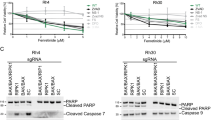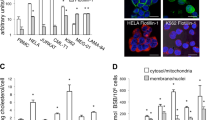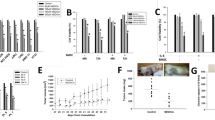Abstract
In the search for retinoids active against Burkitt's lymphoma (BL), we found that the arotinoid mofarotene (Ro 40-8757) induced strong antiproliferative and apoptotic responses in most established BL cell lines as well as in primary BL cells. Ro 40-8757-induced apoptosis is associated with mitochondrial membrane depolarization, activation of caspase-3 and -9, and enhanced production of reactive oxygen species. These effects were related to a transient drop in intracellular ATP content, probably favored by a downregulation of NADH dehydrogenase subunit-1, a component of the mitochondrial respiratory chain (MRC) Complex I. Inhibition of MRC with thenoyltrifluoroacetone suppressed both the ATP recovery and apoptosis, confirming that the effects of Ro 40-8757 are mediated by changes in mitochondrial function. Compared to EBV-negative lines, EBV-carrying BLs were more resistant to Ro 40-8757-induced apoptosis. EBV infection and ectopic LMP-1 expression increased the resistance of BL cells to Ro 40-8757-induced apoptosis, probably through bcl-2 upregulation. Finally, we also show that 2-methoxyoestradiol, an inhibitor of the scavenger enzymes superoxide dismutases, enhanced Ro 40-8757-mediated apoptosis. These findings provide the rationale for evaluating the clinical efficacy of Ro 40-8757 in BL patients and suggest that the combination of Ro 40-8757 with inhibitors of scavenger enzymes may be a promising therapeutic approach for this aggressive lymphoma.
This is a preview of subscription content, access via your institution
Access options
Subscribe to this journal
Receive 50 print issues and online access
$259.00 per year
only $5.18 per issue
Buy this article
- Purchase on Springer Link
- Instant access to full article PDF
Prices may be subject to local taxes which are calculated during checkout










Similar content being viewed by others
References
Barrientos A and Moraes CT . (1999). J. Biol. Chem., 274, 16188–16197.
Buttke TM and Sandstrom PA . (1994). Immunol. Today, 15, 7–10.
Cariati R, Zancai P, Quaia M, Cutrona G, Giannini F, Rizzo S, Boiocchi M, Dolcetti R . (2000). Int. J. Cancer, 86, 375–384.
Castleberry RP, Emanuel PD, Zuckerman KS, Cohn S, Strauss L, Byrd RL, Homans A, Chaffee S, Nitschke R and Gualtieri RJ . (1994). N. Engl. J. Med., 331, 1680–1684.
Chomczynski P and Sacchi N . (1987). Anal. Biochem., 162, 156–159.
Eliason JF, Baumgartner M, Yoshikubo T, Hirabayashi Y, Mitsui H and Inoue T . (1995). Blood, 86, 4516–4526.
Eliason JF, Inoue T, Kubota A, Horii I and Hartmann D . (1994). Int. J. Cancer, 57, 192–197.
Eliason JF, Kaufmann F, Tanaka T and Tsukagushi T . (1993). Br. J. Cancer, 67, 1293–1298.
Falk MH, Meier T, Issels RD, Brielmeier M, Scheffer B and Bornkamm GW . (1998). Int. J. Cancer, 75, 620–625.
Fenaux P, Chomienne C and Degos L . (1997). Semin Oncol., 24, 92–102.
French LE, Ramelet AA and Saurat J-H . (1994). Lancet, 344, 686–687.
Fridovich I . (1995). Annu. Rev. Biochem., 64, 97–112.
Hartmann D, Teelmann K, Eliason J, Kaufmann F and Klaus M . (1993). Retinoids: Progress in Research and Clinical Applications. Livrea MA, Packer L (eds). Marcel Dekker: New York, NY, pp. 491–502.
Hecht JL and Aster JC . (2000). J. Clin. Oncol., 18, 3707–3721.
Henderson S, Rowe M, Gregory C, Croom-Carter D, Wang F, Longnecker R, Kieff E and Rickinson A . (1991). Cell, 65, 1107–1115.
Higuchi M, Proske RJ and Yeh ETH . (1998). Oncogene, 17, 2515–2524.
Hockenbery D, Nunez G, Milliman C, Schreiber RD and Korsmeyer SJ . (1990). Nature, 348, 334–336.
Huang P, Feng L, Oldham EA, Keating MJ and Plunkett W . (2000). Nature, 407, 390–395.
Knowles DM, Chamulak GA, Subar M, Burke JS, Dugan M, Wernz J, Slywotzky C, Pelicci G, Dalla-Favera R and Raphael B . (1988). Ann. Intern. Med., 108, 744–753.
Komano J, Maruo S, Kurozumi K, Oda T and Takada K . (1999). J. Virol., 73, 9827–9831.
Kroemer G and Reed JC . (2000). Nat. Med., 6, 1067–1074.
Louvet C, Djelloul S, Forgue-Lafitte M-E, Mester J, Zimber A and Gespach C . (1996). Br. J. Cancer, 74, 394–399.
Marton A, Mihalik R, Bratincsák A, Adleff V, Petak I, Vegh M, Bauer PI and Krajcsi P . (1997). Eur. J. Biochem., 250, 467–475.
Morrison VA and Peterson BA . (1999). Semin. Oncol., 26, 84–98.
Nishikawa T, Edelstein D, Du XL, Yamagishi S, Matsumura T, Kaneda Y, Yorek MA, Beebe D, Oates PJ, Hammes HP, Giardino I and Brownlee M . (2000). Nature, 404, 787–790.
Ohno R . (1994). Leuk. Lymph., 14, 401–409.
Pettus EH, Betarbet R, Cottrell B, Wallace DC, Madyastha V and Greenamyre JT . (2000). J. Neurochem., 75, 383–392.
Pitkanen S and Robinson BH . (1996). J. Clin. Invest., 98, 345–351.
Pomponi F, Cariati R, Zancai P, De Paoli P, Rizzo S, Tedeschi RM, Pivetta B, De Vita S, Boiocchi M and Dolcetti R . (1996). Blood, 88, 3147–3159.
Pryor WA . (1982). Ann. N.Y. Acad. Sci., 393, 1–22.
Richter C and Schweizer M . (1997). Oxidative Stress and the Molecular Biology of Antioxidant Defenses. In: Scandalios JG (ed). Cold Spring Harbor Laboratory Press: Plainview, NY, pp. 169–200.
Richter C, Schweitzer M, Cossarizza A and Franceschi C . (1996). FEBS Lett., 378, 107–110.
Rothe G and Valet G . (1990). J. Leukoc. Biol., 47, 440–448.
Ruf IK, Rhyne PW, Yang C, Cleveland JL and Sample JT . (2000). J. Virol., 74, 10223–10228.
Seaton TA, Cooper JM and Schapira AHV . (1998). Brain Res., 809, 12–17.
Slater AF, Nobel CS and Orrenius S . (1995). Biochim. Biophys. Acta, 1271, 59–62.
Teelmann K, Tsukaguchi T, Klaus M and Eliason JF . (1993). Cancer Res., 53, 2319–2325.
Uchida T, Inagaki N, Furuichi Y and Eliason JF . (1994). Int. J. Cancer, 58, 891–897.
White L, Siegel SE and Quah TC . (1992). Crit. Rev. Oncol. Hematol., 13, 55–71.
Xu J, Ahmad A, D’Addario M, Knafo L, Jones JF, Prasad U, Dolcetti R, Vaccher E and Menezes J . (2000). J. Immunol., 164, 2815–2822.
Acknowledgements
This work was supported in part by grants from the Italian Association for Cancer Research (AIRC) (to R.D.) and from MIUR, Progetto Strategico “Oncologia” (SP/4), Legge 449/97, No. 02.00268.ST97. The authors thank Dr Werner Bollag (Hoffmann-La Roche S.p.A.) for supplying Ro 40-8757, Dr J Menezés for providing the LMP-1-transfected BJAB cells and the S12 antibody, Dr JT Greenamyre for the kind gift of anti-ND1 antibody; and Dr P Tonel and Mrs P Pistello for help with the manuscript. PZ and RC are recipients of fellowships from the Italian Foundation for Cancer Research (FIRC)
Author information
Authors and Affiliations
Corresponding author
Rights and permissions
About this article
Cite this article
Cariati, R., Zancai, P., Righetti, E. et al. Inhibition of oxidative phosphorylation underlies the antiproliferative and proapoptotic effects of mofarotene (Ro 40-8757) in Burkitt's lymphoma cells. Oncogene 22, 906–918 (2003). https://doi.org/10.1038/sj.onc.1206060
Received:
Revised:
Accepted:
Published:
Issue Date:
DOI: https://doi.org/10.1038/sj.onc.1206060



